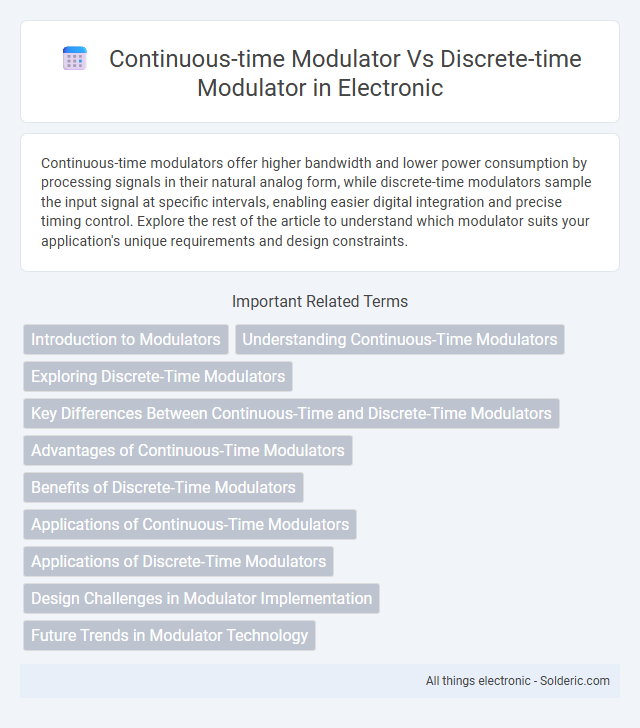Continuous-time modulators offer higher bandwidth and lower power consumption by processing signals in their natural analog form, while discrete-time modulators sample the input signal at specific intervals, enabling easier digital integration and precise timing control. Explore the rest of the article to understand which modulator suits your application's unique requirements and design constraints.
Comparison Table
| Feature | Continuous-Time Modulator | Discrete-Time Modulator |
|---|---|---|
| Signal Processing | Processes analog signals continuously over time | Processes signals at specific sampling intervals |
| Sampling | No explicit sampling; operates in real-time | Involves sampling and discrete-time operations |
| Frequency Bandwidth | High bandwidth, limited by circuit non-idealities | Bandwidth limited by Nyquist sampling criteria |
| Noise Shaping | Improved noise shaping with continuous filtering | Noise shaping depends on discrete filter design |
| Implementation | Analog circuits with continuous feedback loops | Digital components with clocked sampling |
| Power Consumption | Generally lower power due to continuous-time operation | Higher power consumption due to sampling and digital processing |
| Latency | Low latency due to continuous processing | Latency affected by discrete sampling and processing delay |
| Applications | High-speed ADCs, communication receivers | Digital audio, image processing, ADCs with oversampling |
Introduction to Modulators
Continuous-time modulators process analog signals in real-time without sampling, enabling smoother frequency responses and lower latency. Discrete-time modulators rely on sampled data and digital processing, offering precise control and ease of integration with digital systems. Understanding the differences between these modulators helps you select the right approach for optimizing signal fidelity and system performance in communication and control applications.
Understanding Continuous-Time Modulators
Continuous-time modulators operate directly on continuous input signals without sampling, enabling higher bandwidth and faster response for analog-to-digital conversion in sigma-delta modulators. These modulators leverage continuous-time loop filters to reduce thermal noise and clock jitter sensitivity compared to discrete-time counterparts. Their design complexity increases with process variations but offers improved power efficiency and signal fidelity for high-speed data acquisition systems.
Exploring Discrete-Time Modulators
Discrete-time modulators sample and process signals at specific intervals, enabling efficient digital implementation and compatibility with modern digital communication systems. You benefit from precise control over quantization noise shaping and flexibility in digital filter design, making discrete-time modulators ideal for sigma-delta analog-to-digital converters (ADCs). Compared to continuous-time modulators, they offer greater robustness to non-idealities, such as clock jitter and component variations, enhancing overall signal fidelity in complex applications.
Key Differences Between Continuous-Time and Discrete-Time Modulators
Continuous-time modulators process signals in an uninterrupted manner, offering higher bandwidth and faster response suitable for real-time applications, whereas discrete-time modulators sample input signals at specific intervals, enabling easier digital implementation and improved noise shaping capabilities. Continuous-time designs typically feature analog filters with inherent anti-aliasing properties, contrasting with discrete-time modulators that rely on digital filters and require explicit anti-aliasing measures. Additionally, discrete-time modulators excel in integrating with digital signal processing systems, while continuous-time modulators provide superior performance in high-frequency and low-latency scenarios.
Advantages of Continuous-Time Modulators
Continuous-time modulators offer higher bandwidth and better noise shaping due to their inherent analog signal processing, enabling superior performance in high-speed applications. They eliminate the need for anti-aliasing filters, reducing circuit complexity and power consumption. Your system benefits from improved linearity and reduced aliasing distortion, making continuous-time modulators ideal for RF and wideband communication systems.
Benefits of Discrete-Time Modulators
Discrete-time modulators offer enhanced precision and flexibility in digital signal processing applications by enabling exact control over signal sampling and quantization. They facilitate easier implementation of complex algorithms and noise shaping techniques, leading to improved signal-to-noise ratio and reduced distortion. Your digital system benefits from increased scalability and integration capabilities compared to continuous-time modulators.
Applications of Continuous-Time Modulators
Continuous-time modulators are extensively used in high-speed communications and wideband analog-to-digital conversion due to their inherent ability to process signals in real time without the need for sampling, making them ideal for RF and broadband applications. Their continuous operation enables better noise shaping and lower latency compared to discrete-time modulators, which rely on clocked sampling techniques. Practical deployments include ultra-wideband transceivers, high-frequency sigma-delta ADCs, and real-time signal processing systems requiring high linearity and dynamic range.
Applications of Discrete-Time Modulators
Discrete-time modulators find extensive applications in digital communication systems, including digital signal processing, data converters, and wireless communication technologies. Your digital devices rely on discrete-time modulators for efficient signal encoding, noise shaping, and compact implementation in microprocessors and FPGAs. These modulators enable precise control over quantization noise, making them essential in audio codecs, sigma-delta ADCs, and digital control systems.
Design Challenges in Modulator Implementation
Continuous-time modulators face design challenges such as sensitivity to clock jitter and amplification of circuit non-idealities, requiring precise continuous-time filters and robust feedback loop stability. Discrete-time modulators must tackle issues related to capacitor matching, switch noise, and finite op-amp gain, demanding careful timing control and accurate sampling to minimize thermal and quantization noise. Both types need to balance trade-offs between linearity, power consumption, and noise shaping to achieve optimal modulator performance.
Future Trends in Modulator Technology
Future trends in modulator technology emphasize increased integration of continuous-time modulators with digital signal processing to enhance bandwidth and power efficiency. Advances in discrete-time modulators focus on higher sampling rates and improved noise shaping for ultra-high-resolution analog-to-digital conversion. Emerging designs harness machine learning algorithms to optimize modulator performance, catering to 5G communication systems and next-generation radar applications.
Continuous-time modulator vs discrete-time modulator Infographic

 solderic.com
solderic.com